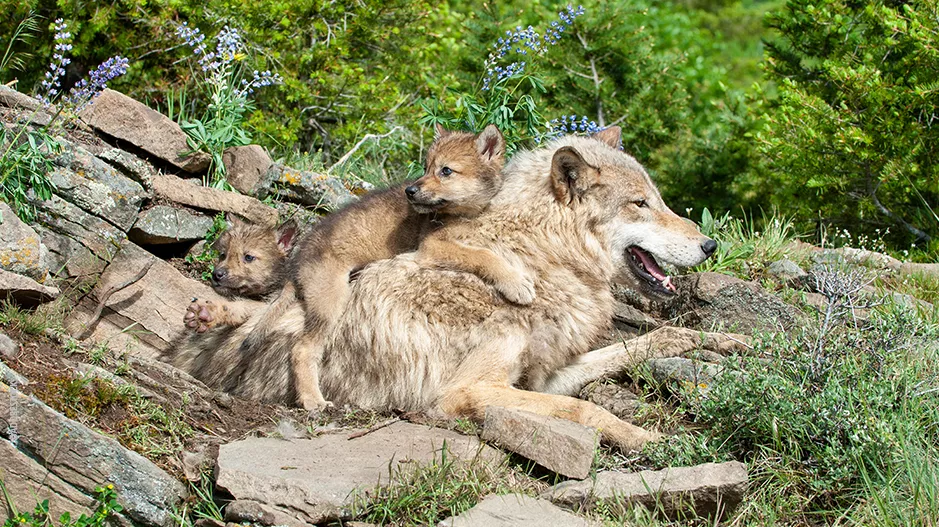
A FRESH-FNRS thesis about wolves
Footprints that had not been seen for a long time in our woods: there is no doubt they belong to wolves. Back in Belgium, there are currently two packs located in the High Fens and Kempen regions.
What is the history of this animal in our regions? This is the subject of Julie Duchêne's thesis, a doctoral student in the Department of history who is studying the presence of the wolf in Wallonia from the 18th to the 20th century.
Why have wolves disappeared from our regions?
During the French period (1792-1815), the State set up a national wolf regulation plan (granting premiums to encourage their regulation, organisation of drives by the communes). With this plan, wolf regulation became more systematic and effective. The State's objective was to reduce the nuisance. Improved weapons also contributed to the wolf's disappearance, as well as indirect factors such as the reduction of its natural habitat due to the development of agriculture and livestock farming. The territories become much more fragmented and a reduction in the fauna is noted. With its habitat reduced and food more difficult to find, the wolf will turn to domestic prey, i.e., livestock. Breeders then view it negatively, as a large predator that poses a threat to livestock.
Has the wolf always had a bad reputation, as our traditional tales give it a frightening appearance?
First of all, it cannot be said that man has an irrational fear of the wolf, otherwise he would not hunt it. This means that man is not afraid of the wolf, but rather of its harmful behaviour and the damage it can cause by attacking livestock. Certain theses that have been carried out in France also demonstrate the influence of the Catholic religion on our imagination and our perception of the wolf: Jesus guides believers as a shepherd does with his sheep, while the wolf threatens the sheep and in a way embodies the devil.
However, the wolf has not always been perceived negatively. For example, during the Roman Empire, the wolf was the animal symbol of Rome. It is therefore clear that, depending on the society in which one evolves, the image of the wolf can vary over time, and go from positive to negative or vice versa.
The view of Benoît Muylkens, Head of the Department of veterinary medicine
Benoît Muylkens talks about the problems associated with the cohabitation of wolves and farmers.
"We can't say that these "surprise" tenants are making people happy in the world of animal husbandry. Indeed, to avoid attacks, some farmers in the vicinity of the packs must take measures that are costly. Fences are sometimes needed, sometimes electrified, but this is a big investment. Another solution is to have a dog adapted to the protection of the herds, but here again, this type of dog is difficult to find and to train is not easy. The reappearance of these predators will certainly contribute to a better regulation of large ungulates in the forests (deer, roe deer, wild boar). Their excessive density causes damage to trees and shrubs. The return of the wolf will help to regulate these populations in wild biotopes, but the proximity of sheep farms leads to undesirable attacks.
The wolf, an ideal culprit
Attacks do occur, but they are not always the fault of the wolf, contrary to what one might think. Benoit Muylkens qualifies: "In many cases, so-called 'wolf attacks' are the result of dog attacks or the consequence of natural deaths, but since the wolf is present, it is easier to blame the wolf. However, the genetic analyses carried out systematically by the experts of the wolf network demonstrate that in many cases, the wolf can be excluded as the cause of death in all suspected attacks for which they have been mandated. According to him, systematically pointing the finger at the wolf is not totally justified, especially when we know that other wild species pose other problems. "Every week, there are car accidents caused by game crossing our roads without any press coverage. But we hear more about wolf attacks, which do occur, but at a relatively low frequency," he says.
A conference about the wolf at the UNamur: a fascinating subject!
More than 200 people attended the conference "The return of the wolf in Wallonia" on 9 March 2023, and about a hundred people followed it online! Organised by Laurent Tallier, from the University Community Life Service (Vecu) of UNamur, and by the students of the UNamur veterinary circle, the conference gave the floor to various speakers, including Alain Licoppe, head of the "Wolf Network" at the SPW, who gave an update on the Wolf Plan, and Johan Michaux, professor at the ULiège and director of the Conservation Genetics Laboratory, who came to explain his research on the genetic analysis of the wolf.

Several sheep breeders were also present and shared their point of view on the subject. During this conference, Alain Licoppe notably returned to the origin of the two wolf packs installed in Belgium. According to the expert, the wolf pack in the Campine region comes from the German-Polish lineage that migrated from northern Germany. The second one in the Hautes Fagnes is from individuals that migrated from the Italian-Alpine population.
In addition, the public had the opportunity to discover a dozen didactic panels explaining various aspects of the biology, behaviour and migratory flows of wolves. A successful evening!

